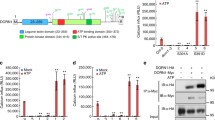Abstract
In this commentary, important recent discoveries on effector-mediated manipulation of apoplast hydration and the involvement of ABA machinery that are targeted in later stages of bacterial infection culminating in stomatal closure are highlighted. This article also sheds light on the differences in early and later stages of infection wherein the COR signaling in the initial phase promotes stomatal opening while in later stages ABA signaling overrides and forces the stomata to close. Also, the current understanding of pathogen-driven modulation of leaf water status during infection, in which stomata act as a crucial battleground between pathogens and plants at the post-invasive stage is summarized.

Similar content being viewed by others
Abbreviations
- ABA:
-
Abscisic acid
- COR:
-
Coronatine
- Pst:
-
Pseudomonas syringae
- TBHQ:
-
Tert-butylhydroquinone
- TOPP:
-
Type one protein phosphatase
References
Aung K, Jiang Y, He SY (2018) The role of water in plant–microbe interactions. Plant J 93:771–780
Beattie GA (2011) Water relations in the interaction of foliar bacterial pathogens with plants. Annu Rev Phytopathol 49:533–555
Chen K, Li GJ, Bressan RA, Song CP, Zhu JK, Zhao Y (2020) Abscisic acid dynamics, signaling, and functions in plants. J Integr Plant Biol 62:25–54
Hou YJ, Zhu Y, Wang P, Zhao Y, Xie S, Batelli G, Wang B, Duan CG, Wang X, Xing L et al (2016) Type one protein phosphatase 1 and its regulatory protein inhibitor 2 negatively regulate ABA signaling. PLoS Genet 12:e1005835
Hu Y, Ding Y, Cai B, Qin X, Wu J, Yuan M, Wan S, Zhao Y, Xin X-F (2022) Bacterial effectors manipulate plant abscisic acid signaling for creation of an aqueous apoplast. Cell Host Microbe 30:1–12
Kang J, Hwang JU, Lee M, Kim YY, Assmann SM, Martinoia E, Lee Y (2010) PDR-type ABC transporter mediates cellular uptake of the phytohormone abscisic acid. Proc Natl Acad Sci USA 107:2355–2360
Liu Z, Hou S, Rodrigues O et al (2022a) Phytocytokine signalling reopens stomata in plant immunity and water loss. Nature 605:332–339
Liu XD, Hasan MM, Fang XW (2022b) Phytocytokine SCREWs increase plant immunity through actively reopening stomata. J Plant Physiol 279:153832
Lovelace AH, Ma W (2022) How do bacteria transform plants into their oasis? Cell Host Microbe 30(4):412–414
Macho AP (2016) Subversion of plant cellular functions by bacterial type-III effectors: beyond suppression of immunity. New Phytol 210:51–57
Melotto M, Underwood W, He SY (2008) Role of stomata in plant innate immunity and foliar bacterial diseases. Annu Rev Phytopathol 46:101–122
Roussin-Léveillée C, Lajeunesse G, St-Amand M, Veerapen VP, Silva-martins G, Nomura K, Brassard S, Bolaji A, He SY, Moffett P (2022) Evolutionarily conserved bacterial effectors hijack abscisic acid signaling to induce an aqueous environment in the apoplast. Cell Host Microbe 30:1–13
Torii KU (2022) Plant signaling: Peptide-receptor pair re-opens stomata after pathogen infection. Curr Biol 32(14):R783–R786
Wang M, Ji Q, Liu P, Liu Y (2022) Guarding and hijacking: stomata on the move. Trends Plant Sci 27(8):736–738
Xin XF, Nomura K, Aung K, Velásquez AC, Yao J, Boutrot F, Chang JH, Zipfel C, He SY (2016) Bacteria establish an aqueous living space in plants crucial for virulence. Nature 539:524–529
Funding
Projects in the MS-K lab are supported by core funding from the National Institute of Plant Genome Research. AC was supported by a DBT-senior research fellowship (DBT/2014/NIPGR/261).
Author information
Authors and Affiliations
Corresponding author
Ethics declarations
Conflict of interest
The authors declare that they have no conflict of interest.
Additional information
Publisher's Note
Springer Nature remains neutral with regard to jurisdictional claims in published maps and institutional affiliations.
Rights and permissions
Springer Nature or its licensor (e.g. a society or other partner) holds exclusive rights to this article under a publishing agreement with the author(s) or other rightsholder(s); author self-archiving of the accepted manuscript version of this article is solely governed by the terms of such publishing agreement and applicable law.
About this article
Cite this article
Choudhary, A., Senthil-Kumar, M. The war for apoplastic water: stomatal control as a key strategy in bacterial pathogenesis. J. Plant Biochem. Biotechnol. 32, 8–11 (2023). https://doi.org/10.1007/s13562-022-00820-2
Received:
Accepted:
Published:
Issue Date:
DOI: https://doi.org/10.1007/s13562-022-00820-2




